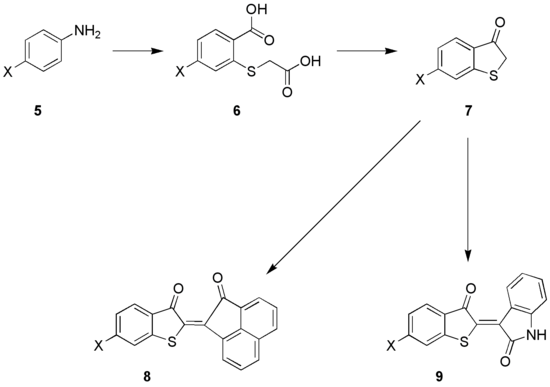Heart reaction
The heart reaction is an organic chemical name reaction named after Richard Herz . An aniline derivative 1 is converted into a so-called disulfur dichloride with it . Heart salt 2 converted, the hydrolysis of which yields a thiophenol derivative 3 :
Applications
Benzothiazoles
The sodium thiophenolate 3 reacts with zinc sulfate to form a zinc mercaptide, the reaction of which with a carboxylic acid chloride - z. B. Benzoyl chloride - leads to 1,3- benzothiazole 4 :
Dyes
Aniline 5 is converted into indigo-like dyes 8 and 9 in several steps :
- Heart reaction of aniline 5 with disulfur dichloride with subsequent hydrolysis, then
- Implementation in the ortho- aminoarylthioglycolic acid and
- Conversion of the amino function into a nitrile via the Sandmeyer reaction .
- Hydrolysis of the nitrile with formation of the carboxylic acid 6 , which then gives the cyclization product 7 with decarboxylation .
- The thioindoxyl 7 condenses with acenaphthoquinone to 8 , a dye of the so-called. Ciba scarlet type.
- The condensation of 7 with isatin leads to the thioindigo dye 9 .
Individual evidence
- ↑ WK Warburton: Arylthiazathiolium Salts And o-aminoaryl thiol - The Heart Reaction . In: Chemical Reviews . 57, No. 5, 1957, pp. 1011-1020. doi : 10.1021 / cr50017a004 .


